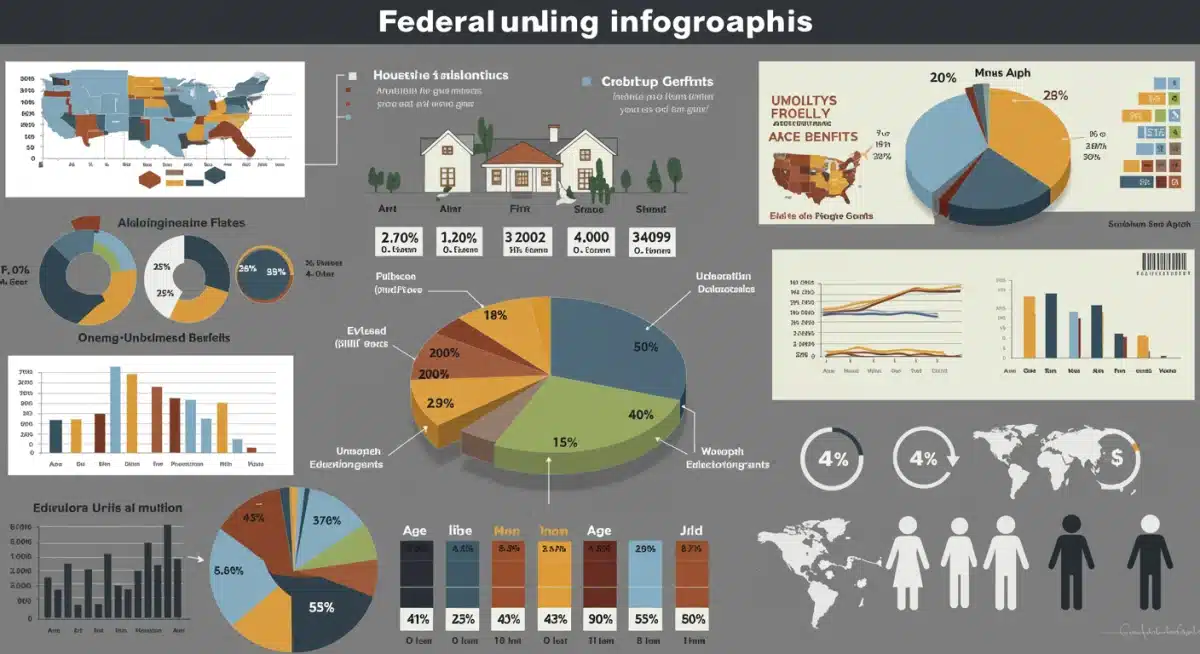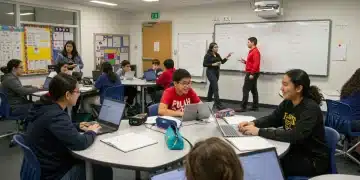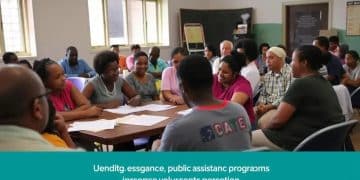New Federal Aid Package 2025: Impacting 40 Million Americans

The newly approved federal aid package for 2025 will significantly impact over 40 million Americans by providing essential financial assistance and bolstering various social and economic programs nationwide.
In a landmark decision, a new federal aid package for 2025 has been approved, poised to bring significant relief and support to an estimated 40 million Americans. This comprehensive initiative aims to address a range of pressing economic and social challenges across the nation. What does this mean for you, your family, and your community?
Understanding the Scope of the 2025 Federal Aid Package
The recently approved federal aid package for 2025 represents a monumental effort to stabilize and stimulate the U.S. economy while providing direct assistance to those in need. This legislation is not merely a short-term fix but a strategic investment in the nation’s future, designed to foster long-term recovery and resilience.
Its broad scope encompasses various sectors, from direct financial relief for individuals to substantial investments in infrastructure and education. The package reflects a concerted effort by policymakers to respond to evolving economic landscapes and social demands, ensuring that support reaches a wide demographic.
Key Pillars of Support
The package is structured around several critical areas, each designed to tackle specific challenges faced by American citizens. These pillars are interconnected, aiming to create a holistic support system that addresses both immediate and systemic issues.
- Direct Financial Assistance: Provisions for direct payments or enhanced unemployment benefits to individuals and families experiencing financial hardship.
- Housing and Rental Aid: Increased funding for programs that prevent homelessness and assist with rent and mortgage payments, ensuring stable living conditions.
- Healthcare Expansion: Measures to improve access to affordable healthcare, including subsidies for insurance and funding for public health initiatives.
- Educational Grants and Loans: Significant investments in educational support, from K-12 funding to higher education grants and student loan relief.
Understanding these core components is crucial for appreciating the potential impact of the package. Each pillar serves a vital role in the broader strategy to uplift communities and empower individuals across the country.
Direct Financial Relief and Economic Stabilization
A cornerstone of the 2025 federal aid package is its focus on direct financial relief, aiming to put money directly into the hands of Americans who need it most. This approach is rooted in the belief that immediate financial injection can stimulate local economies and alleviate household stress.
The mechanisms for distributing these funds are being carefully designed to ensure efficiency and equity, minimizing bureaucratic hurdles and maximizing reach. The goal is to provide a much-needed financial cushion, allowing families to cover essential expenses and plan for a more secure future.
Boosting Local Economies
Beyond individual relief, the direct financial aid is expected to have a ripple effect on local economies. When individuals have more disposable income, they are likely to spend it on goods and services, supporting small businesses and creating jobs within their communities. This cyclical benefit is a key objective of the package.
Economists project that this direct injection of capital will help mitigate potential economic downturns and foster a more stable market environment. The stability provided by these funds can also encourage consumer confidence, which is vital for sustained economic growth.
- Consumer Spending Increase: Direct aid often translates to increased spending, benefiting local businesses and stimulating demand.
- Small Business Support: Indirect support for small enterprises through heightened consumer activity and potential grant programs.
- Job Creation: Economic stimulation can lead to job growth as businesses expand to meet increased demand.
The financial relief component is strategically designed to offer both immediate solace and long-term economic benefits, demonstrating a dual approach to national recovery and growth.
Impact on Healthcare and Public Health Initiatives
The 2025 federal aid package allocates substantial resources to enhance healthcare access and bolster public health infrastructure. Recognizing the lessons learned from recent global health crises, the package prioritizes strengthening the nation’s healthcare system to better serve all Americans.
This includes funding for preventative care, mental health services, and initiatives aimed at reducing healthcare disparities. The emphasis is on building a more resilient and equitable healthcare landscape, ensuring that quality care is accessible regardless of socioeconomic status or geographic location.
Expanding Access to Affordable Care
One of the primary goals is to make healthcare more affordable and accessible. This involves expanding eligibility for existing programs, increasing subsidies for health insurance premiums, and investing in community health centers that serve underserved populations. The aim is to reduce the number of uninsured Americans and ensure that everyone can receive necessary medical attention without facing insurmountable financial burdens.
Public health initiatives will also receive a significant boost, with funding directed towards disease prevention, health education campaigns, and improving emergency response capabilities. This proactive approach seeks to safeguard public well-being and prepare the nation for future health challenges.
- Mental Health Services: Enhanced funding for mental health programs, including expanded access to therapy and counseling.
- Telehealth Expansion: Investments in telehealth infrastructure to provide remote medical consultations, especially in rural areas.
- Preventative Health: Programs promoting vaccinations, healthy lifestyles, and early disease detection to reduce long-term healthcare costs.
By focusing on both affordability and comprehensive care, the package aims to create a healthier nation, ready to face future health demands with greater strength and unity.
Educational Support and Workforce Development
Education and workforce development are critical components of the 2025 federal aid package, reflecting a commitment to equipping Americans with the skills needed for a competitive global economy. The package includes significant investments ranging from early childhood education to higher learning and vocational training.
These initiatives are designed to bridge educational gaps, enhance learning environments, and prepare individuals for in-demand jobs. The goal is to foster a highly skilled workforce that can drive innovation and economic growth for decades to come.
Investing in Future Generations
Funding will be directed towards improving K-12 education, including modernizing school facilities, investing in technology, and providing resources for teachers. For higher education, the package aims to make college more affordable through increased Pell Grants, student loan relief programs, and support for community colleges.
Workforce development programs will also receive substantial backing, focusing on reskilling and upskilling initiatives that align with current and future industry needs. These programs will help displaced workers transition into new careers and ensure that the American workforce remains adaptable and competitive.
- Early Childhood Education: Increased funding for preschool programs and childcare subsidies to support working families.
- STEM Education: Investments in science, technology, engineering, and mathematics programs to foster critical skills.
- Vocational Training: Expansion of trade schools and apprenticeship programs to provide practical, job-ready skills.
These educational and workforce initiatives are designed to build a strong foundation for individual success and national prosperity, ensuring that every American has the opportunity to thrive.

Housing Assistance and Community Development
The 2025 federal aid package addresses the critical need for stable housing and robust community development across the nation. Recognizing that secure housing is fundamental to individual well-being and economic stability, the package allocates substantial funds to various housing assistance programs.
These initiatives aim to prevent homelessness, support affordable housing projects, and revitalize communities that have experienced economic hardship. The focus is on creating sustainable living environments where all Americans can thrive.
Strengthening Housing Stability
The package includes provisions for rental assistance, mortgage relief, and support for housing counseling services. These measures are designed to help individuals and families maintain their homes, preventing evictions and foreclosures that can have devastating long-term effects. Additionally, funding will be channeled into constructing and rehabilitating affordable housing units, increasing the supply of safe and accessible homes.
Community development efforts will also see a boost, with investments in infrastructure improvements, public services, and economic revitalization projects in underserved areas. These initiatives aim to create vibrant, resilient communities that offer opportunities for all residents.
- Homelessness Prevention: Increased funding for emergency shelters, rapid re-housing programs, and supportive services for individuals experiencing homelessness.
- Affordable Housing Initiatives: Grants and tax incentives for developers to build and preserve affordable housing units.
- Infrastructure Upgrades: Investments in local infrastructure, such as water systems, public transportation, and community centers, to improve quality of life.
By prioritizing housing stability and community growth, the federal aid package seeks to build stronger foundations for individuals and communities, fostering environments where everyone has the chance to succeed.
Implementation Challenges and Oversight
While the approval of the 2025 federal aid package is a significant step, its successful implementation will depend on overcoming several challenges. Ensuring that funds are distributed efficiently, equitably, and transparently is paramount to achieving the desired impact for 40 million Americans.
Robust oversight mechanisms will be crucial to prevent fraud, waste, and abuse, guaranteeing that every dollar reaches its intended recipient and purpose. The government is committed to establishing clear guidelines and accountability measures to ensure the package’s effectiveness.
Ensuring Equitable Distribution
One of the primary challenges lies in ensuring equitable distribution across diverse communities and demographics. Special attention will be given to reaching rural areas, underserved populations, and communities that have historically faced systemic barriers to accessing aid. This requires coordinated efforts between federal, state, and local agencies.
Technological solutions will play a key role in streamlining the application and distribution processes, making it easier for eligible individuals and organizations to access funds. Public awareness campaigns will also be launched to inform citizens about the available programs and how to apply for assistance.
- Inter-Agency Coordination: Collaboration among government bodies to ensure seamless delivery of aid across all levels.
- Transparency Measures: Public dashboards and reports detailing how funds are allocated and utilized.
- Community Outreach: Targeted efforts to inform and assist vulnerable populations in accessing aid programs.
Effective implementation and stringent oversight are essential to maximize the positive impact of this historic federal aid package, ensuring it genuinely serves the 40 million Americans it aims to support.
Long-Term Economic and Social Implications
The 2025 federal aid package is not just about immediate relief; it carries profound long-term economic and social implications for the United States. By addressing foundational issues in healthcare, education, housing, and economic stability, the package aims to foster sustained growth and reduce future vulnerabilities.
The investments made today are expected to yield benefits for years to come, strengthening the nation’s human capital, infrastructure, and overall resilience. This forward-looking approach seeks to create a more equitable and prosperous society for all.
Building a Resilient Future
Economically, the package is anticipated to reduce income inequality, boost productivity through an educated workforce, and stabilize key sectors of the economy. Socially, it aims to improve public health outcomes, enhance educational attainment, and ensure greater housing security, leading to stronger, more cohesive communities.
The long-term success of the package will be measured not just by economic indicators but also by improvements in the quality of life for millions of Americans. It represents a commitment to a future where opportunity is more accessible and foundational needs are met, paving the way for sustained national progress.
- Reduced Poverty: Long-term effects could include a significant reduction in poverty rates across the country.
- Improved Health Metrics: Better access to healthcare and preventative measures could lead to healthier populations.
- Enhanced Social Mobility: Educational and workforce development programs can create pathways for upward mobility.
Ultimately, the 2025 federal aid package is a strategic investment in the fabric of American society, designed to create a more stable, prosperous, and equitable future for generations to come.
| Key Aspect | Brief Description |
|---|---|
| Targeted Impact | Aims to support over 40 million Americans through various programs. |
| Key Areas | Includes direct financial aid, healthcare, education, and housing assistance. |
| Economic Goals | Stimulate local economies, reduce inequality, and foster long-term growth. |
| Implementation | Requires robust oversight and equitable distribution strategies. |
Frequently Asked Questions About the 2025 Federal Aid Package
Eligibility for the 2025 federal aid package varies by program. It generally targets individuals and families based on income levels, employment status, educational needs, and specific health or housing situations. Detailed criteria will be released by relevant government agencies as programs roll out.
The package includes provisions for various forms of direct financial assistance, such as potential direct payments, enhanced unemployment benefits, and subsidies for essential services. These measures are designed to provide immediate relief and stimulate economic activity at the household level.
The aid package significantly boosts healthcare access by increasing subsidies for health insurance, expanding eligibility for public health programs, and funding community health centers. It also focuses on mental health services and telehealth expansion to reach more individuals.
Educational support includes increased funding for K-12 schools, higher education grants like Pell Grants, student loan relief, and significant investments in workforce development and vocational training programs. The goal is to enhance learning opportunities and job readiness.
Equitable distribution will be ensured through robust oversight, inter-agency coordination, and targeted outreach to underserved communities. Transparency measures, including public reporting, will help monitor fund allocation and prevent misuse, ensuring aid reaches those who need it most.
Conclusion
The approval of the 2025 federal aid package marks a pivotal moment for the United States, promising substantial relief and strategic investments across critical sectors. Designed to impact over 40 million Americans, this comprehensive initiative aims to address immediate financial needs, strengthen healthcare and education systems, ensure housing stability, and foster long-term economic resilience. While implementation will present its own set of challenges, the commitment to equitable distribution and transparent oversight underscores a dedicated effort to build a more stable and prosperous future for all. This package is more than just aid; it is a foundational step towards a stronger, healthier, and more equitable nation.





